Fuchsia is a tree-like shrub or small tree with beautiful flowers of various colors and shapes. It is so popular with flower growers that it is grown around the world. This beauty hails from South America and New Zealand. Growing and caring for the fuchsia in the garden does not cause much trouble, if you choose the right place for planting.
Material Content:
Fuchsia: features of growing in the garden
If you choose the right landing site, then fuchsia will grow well in the garden.
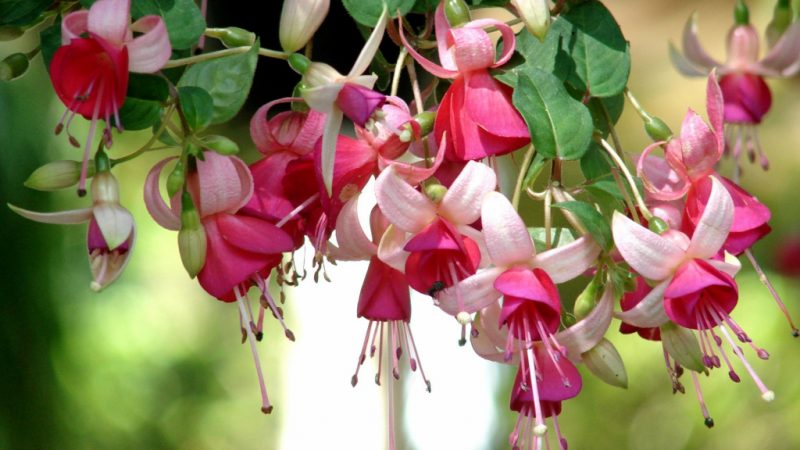
But you need to consider some of its features:
- Fuchsia loves semi-shaded areas with neutral soil acidity.
- It is better to plant where direct sunlight falls only in the mornings and evenings.
- Young plants are planted in open ground in May or June.
- In autumn, fuchsia is cut off and prepared for a long wintering.
Outdoor Care
It is advisable to water it only in the driest periods, and top dressing 1-2 times during the summer with complex fertilizers for flowers.
In autumn, fuchsia is cut off and prepared for a long wintering.
Cut the bush to give the desired shape and enhance flowering. During the warmer months, crown formation may be required only if the goal is to grow shrubs and the plant stubbornly strives to acquire the shape of a tree.
How to care in winter?
In central Russia, in frosty winters, fuchsia flower may suffer.
Features for the care of fuchsia in winter:
- At the end of autumn, the stems are severely pruned, leaving 20-40 cm above the ground, and sheltered for the winter.
- For shelter use spruce branches, tree branches, dry leaves, fragments of polyethylene, tarpaulin.
- It is advisable to cover the sleeping fuchsia with snow at the first opportunity.
- In April, the shelter can be partially dismantled and completely removed in May with the onset of warm days.
- Indoor fuchsia is transferred to a cold room in winter and watered only as the top layer of the earth coma dries up.
The nuances of growing fuchsia at home
Under certain conditions, the plant can be grown at home on the windowsill.
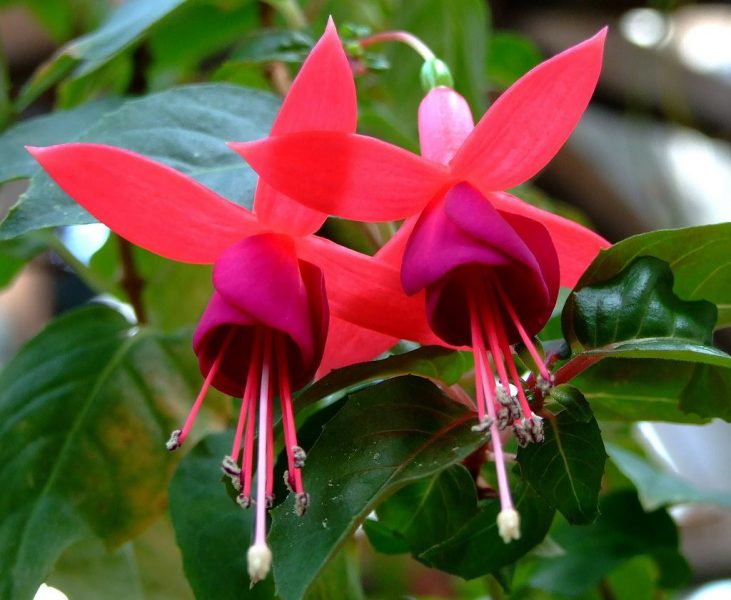
Nuances of growing:
- The most important is the temperature regime. Fuchsia, unlike other indoor plants, loves light coolness in the summer and cold wintering from December to February. The optimum temperature for its growth is 18-20 degrees, and the permissible temperature is up to +23. In a warmer room, she discards leaves and flowers. In hot July days, it is almost impossible to provide such a temperature on the windowsill, unless you turn on the air conditioner.
- Fuchsia flower is quite shade tolerant, so it can be placed on the eastern, western, northeastern and northwestern windows, where, by the way, it is not so hot in summer. On windowsills oriented exactly north, she may be a little short of light.
- Flowering ends in November. At this time, it can be moved to a cold room. In winter, fuchsias are kept on the balcony at a temperature of 6-10 degrees. Under such conditions, photosynthesis slows down, so the plant ceases to need good lighting. For a short time (up to a month) it can be stored in complete darkness.
- Watering is less common and only occurs as the earthen coma dries up. Overmoistening is fraught with decay of the root system.
If you provide everything you need, then the plant will bloom from mid-spring to mid-autumn.
Important! Do not turn the flower pot in order to correct its crown - he loves constancy.
Houseplant Care

Caring for this plant can be divided into 3 main stages:
- Watering. Fuchsia love watering. Their frequency is determined by many factors, the main of which is the rate of drying of the soil. And this, in turn, depends on the humidity of the air, the volume of the root system, the coverage of the earthen coma by the roots, season, etc. The general principle is this: you should water when the top layer of the soil dries up. There must be a drainage hole in the pot, and the volume of water must be calculated so that it saturates the entire earthen lump and appears on the pallet. In other words, it is not watered very often, but abundantly. In cold weather, evaporation decreases, so watering is reduced, sometimes up to two times a month, and in summer it is increased.
- Top dressing. Adult specimens are fed only in the warm season with a frequency of 1-2 times per month. For these purposes, you can purchase universal organic fertilizers for indoor plants or decorative flowers. You should not fertilize too young crops and those that have recently been transplanted into new land or in a pot with a larger capacity.
- Air humidity is quite significant. Many amateur gardeners spray plants from an atomizer to increase humidity. In fact, this is an ineffective method, since water evaporates in 15 minutes. Others put water pots around the pots. This option is better, but not the most rational, because to moisten the air at least 10% have to force them to the entire window sill. The best solution is to place fuchsia among a large number of other indoor plants, because green leaves evaporate a lot of moisture during the growing season. To increase the effect in large pots, you can plant moss, spores of which are easy to find on sale.
Important! If you provide fuchsia with everything you need, then it will bloom from mid-spring to mid-autumn.
Flower propagation
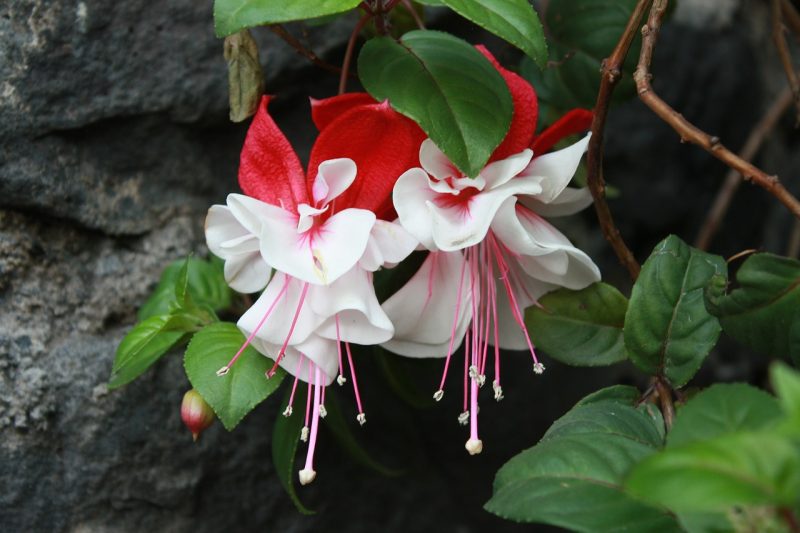
The most affordable and easiest way to propagate fuchsia is cuttings.For this, young shoots 10-20 cm long should be taken. The lower leaves are removed from them at about half the height. Too large leaves are cut or shortened in half too. Cuttings are placed in a container with water and hermetically covered with plastic wrap or a transparent plastic cup. Fans of experiments can also root them in coarse river sand or vermiculite. After 1-2 weeks, you can expect the appearance of roots. After that, you need to make a hole in the covering film in order to start accustoming the seedlings to dry air. Wait another week until their length reaches 2-3 centimeters, after which the cuttings can be planted in small pots.
The soil for fuchsia needs light, loose, rich in organic matter. You can purchase universal soil for indoor plants and dilute it with garden soil. If the resulting substrate seems insufficiently light and moisture permeable, you can add perlite, vermiculite, coconut shavings or sawdust (preferably pine) to it.
Views for open ground and home
For indoor floriculture, breeders specially bred dwarf bush varieties of fuchsia.
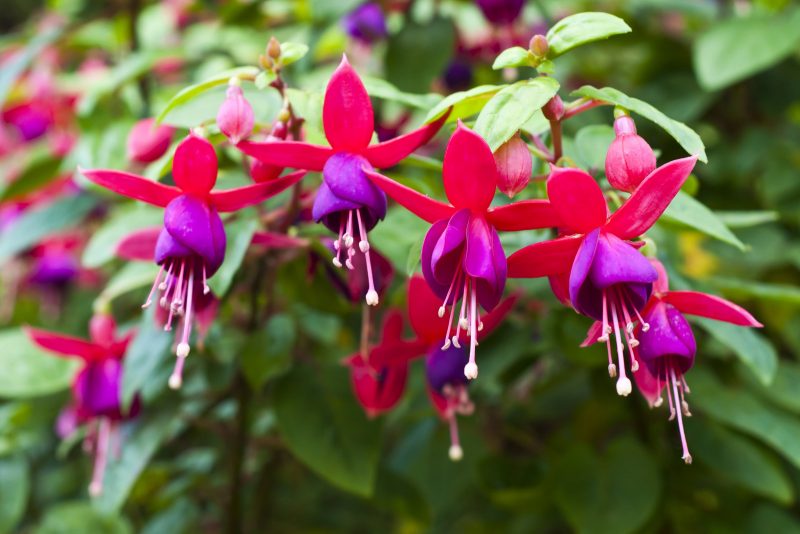
There are about a hundred species, differing in shapes and colors of flowers, but the following are popular:
- Three-leafed;
- Waist
- Anitu;
- Carolina
- Ampelous.
The last of them has many varieties of clones, which are even singled out in a separate category - ampelous.
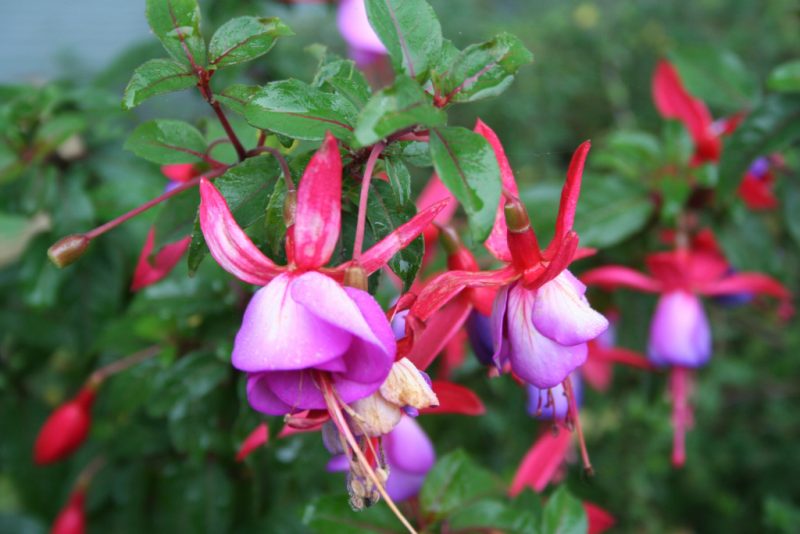
For open ground use cold-resistant varieties of fuchsia: Graceful, Ricarton, Maggelanskaya. With a great desire, street varieties can be grown at home, only take into account that their height can reach 1-1.5 meters.
Diseases, pests in the garden and at home
Fuchsia is a favorite treat for aphids, whiteflies and spider mites. Of the fungal diseases with which it is affected, gray rot and rust can be called.

- Whitefly or aphid. If these pests have settled on a green pet, then you can assume that they got off easily. They can be removed by any drug, on the packaging of which it is indicated that it is an insecticide. It is more difficult to defeat the spider mite. The latter often affects indoor plants, and aphids and whiteflies prefer open ground.
- Among spider mites the most common is its red variety. Insects look like small red dots on the surface of leaves. If you spray them with fine water dust, they will begin to move. One of the most affordable tick drugs is Fitoverm. Only applying it makes sense only at the initial stages of tick reproduction, since with a large population of the pest, there is a high probability of the emergence of individuals resistant to this agent. Induce Fitoverm twice as much concentration than is recommended on the package. After a week, the spraying is repeated, even when it seems that the tick is no longer there. If after a month the tick is not detected, then there is a hope that it was defeated.
- If the pest managed to multiply and become popular not only with fuchsia, but also with other plants, then more powerful means will be needed: Sunmayt, Omayt, Neoron, Oberon, Bitoksibalitsin. These drugs have a moderately toxic effect on the human body, so after treatment you can not stay for a long time near the plant. It is better to put it in a room where no one will go in for 10-12 hours. But, even in the most advanced cases, the tick is removed forever after one spraying.
- Rust - a fungal disease that is easy to diagnose by the appearance of the leaves: they seem to become covered with rust. You can stop its spread with the help of Bordeaux liquid or other fungicides.
- Gray rot It looks like gray-brown spots on the stem or a light, light gray coating on the leaves, especially young ones. If you do not fight it, then in the future the color of the affected areas becomes darker. Heavily damaged leaves are cut off, and plants, including those in the healthy neighborhood, are treated with Fitosporin or Bordeaux fluid.
What problems can flower growers face?
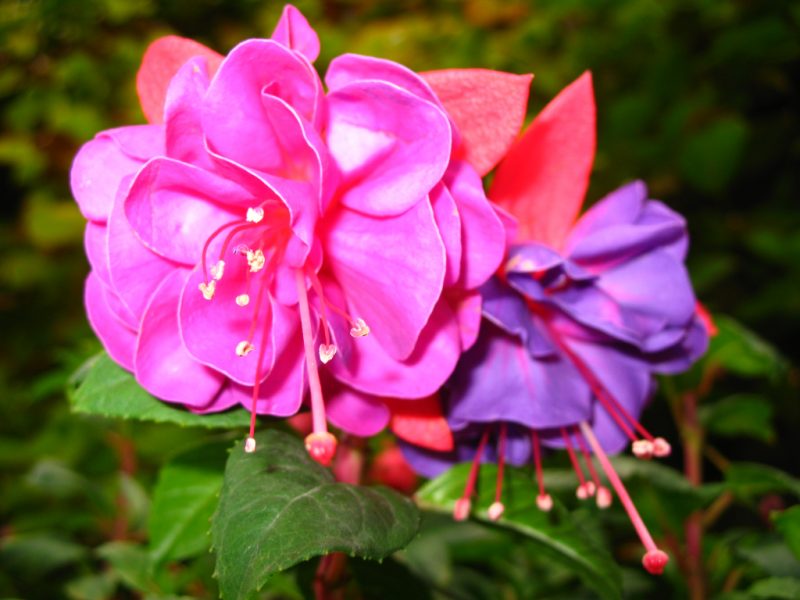
When growing Fuchsia, sometimes problems arise:
- The main difficulty is providing coolness in the summer. In open ground, fuchsia is planted in the shade, and in apartments - placed on windows that do not face south. If the flowers, leaves, and tips of fuchsia stems become drooping for no apparent reason, then it is likely to suffer from excess heat. If possible, it should be moved to a cool room or transplanted to another place.
- The second difficulty is finding a suitable room for a cold wintering, if the plant is indoor, or taking measures to prevent freezing of the tree in the open ground in the frosty months. In the latter case, the issue is decided by the selection of a frost-resistant variety and shelter for the winter.
Despite some completely resolvable difficulties, gardeners and flower growers all over the world strive to propagate fuchsia. And this is not surprising, because she is so beautiful! And everyone can join this magnificence.












